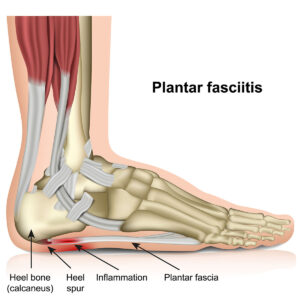“Treating the cause of plantar fasciitis, heals your heel pain!”
Have you experienced sharp pain on your foot for no specific reason? Does your pain increase with prolonged standing and walking? Do you have more pain when you first step in the morning? Most likely, you’re having plantar fasciitis.
What is Plantar Fasciitis?
 Plantar fasciitis is one of the most common causes of heel pain. The plantar fascia is the structure that connects the heel bone to the toes. It supports the arch of the foot while permitting mobility. It also absorbs shock and distributes the pressure when standing and walking. But when overused, it gets inflamed, resulting in pain.
Plantar fasciitis is one of the most common causes of heel pain. The plantar fascia is the structure that connects the heel bone to the toes. It supports the arch of the foot while permitting mobility. It also absorbs shock and distributes the pressure when standing and walking. But when overused, it gets inflamed, resulting in pain.
The patient typically feels a stabbing pain under the heel, especially in the morning. It often goes away with movement or stretching. The symptoms tend to reoccur after prolonged rest or standing for a while. But heel pain becomes constant as it gets worse.
Common Causes of Plantar Fasciitis
Some of the causes of plantar fasciitis include activity, weight, and gender. Specific activities that place stress on the heel, such as running or dancing, can also be a factor. Women often tend to get affected than men, most often when pregnant.
Mini tears develop in the plantar fascia when there is too much tension during weight-bearing. When left untreated, the damage worsens, and you may need surgery. Physical therapy plays a vital role in relieving pain and helps avoid surgery.
Importance of Proper Exercise & PT
People who suffer from plantar fasciitis have weaker and stiffer foot and ankle muscles. The therapist will check the tissues affected and pinpoint the source of the pain. He or she will also evaluate the strength and flexibility of the muscles and tissues to figure out the best treatment plan.
A proper exercise program can strengthen the ankle and foot muscles, which reduces the strain on the plantar fascia — stopping the cycle of pain and discomfort kick off the healing process.
The PT may also combine exercises for plantar fasciitis with shoe inserts and taping. The inserts that conform to the unique shape and arches of your feet. In addition, kinesiotaping also reinforce the arch of your foot to help with the healing. Pain medication, as prescribed by your doctor, ice, and rest, are helpful to start.
A Step in the Right Direction
Surgery is an option if it gets worse but should be considered as the last resort.
The best way to take care of plantar fasciitis is to exercise and modify activity. As a weight-bearing tissue, your feet are under constant tension every day. The Healing can take several weeks or months, and a physical therapist will work with you step by step. The best choice is to work closely with a physical therapist and continue with the prescribed home treatment program.
At CT Physical Therapy Care, we care for your health and recovery. If you know a friend who suffers from heel or foot pain, advice him or her to call us now. We look forward to hearing from you soon. PT is a step to better recovery. Make it a part of your lifestyle. All the best!
